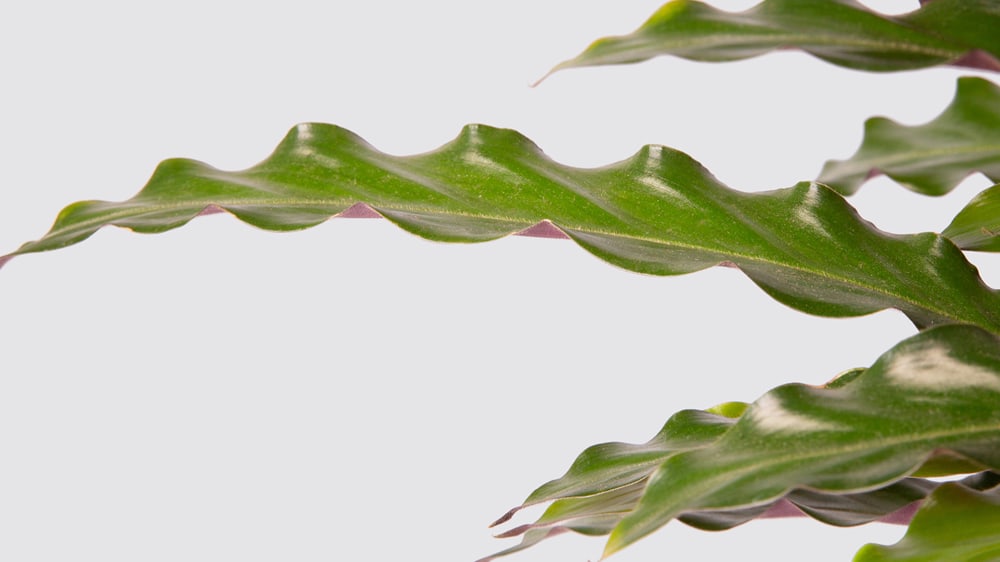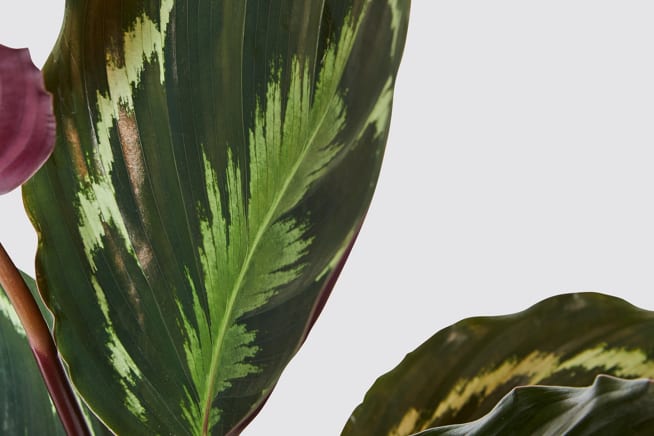Complete guide to calathea 'Elgergrass' care
Velvety leaves and rich colours make the calathea ‘Elgergrass’ a truly luxurious addition to your home.

The calathea rufibarba is a beautiful indoor plant that is popular for its soft, velvety leaves and unique appearance. Also known as the velvet calathea or furry feather, we call ours Jolene. The 'Elgergrass' variety has striking green leaves that are a deep purple underneath, adding a touch of elegance to any room. In this article, we’ll chat through some essential tips for caring for your calathea rufibarba 'Elgergrass'. Key things to remember are:
- Water it little and often, keeping the soil slightly damp
- Bright, indirect light will keep its leaves colourful and vibrant
- Mist your calathea every few days or pop it in a humid spot
About calathea 'Elgergrass'
This particular plant is native to Brazil, where you’ll find it growing in the shade of big trees in tropical rainforests. Like almost all other calathea, its leaves curl up at night, then unfurl in the morning to catch all the rays they can. One of its nicknames is prayer plant, because the curled leaves look like praying hands.
How much light does my calathea ‘Elgergrass’ need?
A calathea rufibarba 'Elgergrass' prefers bright, indirect light. Direct sunlight can scorch the leaves and cause them to turn yellow or brown. This plant will tolerate a bit of shade, but if your plant isn’t getting enough light, you’ll notice that the leaves start to droop or lose their vibrant colour. If that’s the case, move your plant to a brighter spot.
How often should I water my calathea ‘Elgergrass’?
Your calathea rufibarba 'Elgergrass' will enjoy consistently moist soil. Water the plant thoroughly and allow the top inch of soil to dry out before watering again. Just check the soil with your finger. If it comes out dry, it’s time for a drink. Be careful not to overwater, as this can cause root rot. If the soil is too wet, you may notice yellowing or wilting of the leaves. You’ll probably find a weekly water works well, but this will depend on the temperature and humidity of your home. Your calathea ‘Elgergrass’ is sensitive to chlorine, so use filtered water or leave tap water to stand in your watering can overnight before watering.
Does my calathea ‘Elgergrass’ need a humid environment?
A calathea rufibarba 'Elgergrass' thrives in a humid environment. You can increase the humidity levels around the plant by placing a tray of water nearby or using a humidifier. Regularly misting the leaves with a spray bottle can also help to increase humidity levels, or if you’re lucky enough to have a bright bathroom, your calathea will enjoy the natural steam.

What’s the best temperature for my calathea ‘Elgergrass’?
Your calathea rufibarba 'Elgergrass' prefers temperatures between 16°C to 24°C. Try to keep your calathea away from cold draughts or hot radiators. As a rule of thumb, if you’re a good temperature, they will be too.
What’s the best soil for my calathea ‘Elgergrass’?
Your calathea won’t need repotting straight away, but when the time comes it prefers a well-draining soil that is rich in organic matter. You can use a standard houseplant potting mix, just make sure that the soil is loose and well-aerated. Really firm soil can lead to root rot as the water can’t drain away.
Should I fertilise my calathea ‘Elgergrass’?
A calathea rufibarba 'Elgergrass' won’t need regular feeding. Give yours a diluted dose of a slow-release fertiliser once every three months during the growing season (spring and summer), that’s usually enough. Just follow the instructions on the fertiliser packaging and try to avoid over-fertilising, as this can damage the plant.
Should I prune my calathea ‘Elgergrass’?
Your calathea rufibarba 'Elgergrass' doesn’t need to be pruned regularly, but you can trim off any yellow or brown leaves to keep your plant looking fresh. A trim won’t hurt it, but make sure you use clean, sharp scissors to avoid damaging the plant.
Can I propagate my calathea ‘Elgergrass’?
A calathea rufibarba 'Elgergrass' can be propagated by division. To do this, carefully remove the plant from its pot and separate the root ball into two or more sections. Ensure that each section has some roots and foliage, and replant them in fresh potting soil. You can learn more about propagation here.
Caring for a calathea rufibarba 'Elgergrass' is a rewarding experience, and with a little bit of attention, you can help your plant thrive in your home.
Rewild your inbox
Plant tips. Special offers. No spam.
You might like

Complete guide to ctenanthe 'Compactstar' care
It’s gold star for this prayer plant

Complete guide to calathea care
Calatheas are known as the prayer plant but this one doesn’t need divine blessings to survive.

How to make your plants cat-friendly
Help your furry friend and plant pals get along